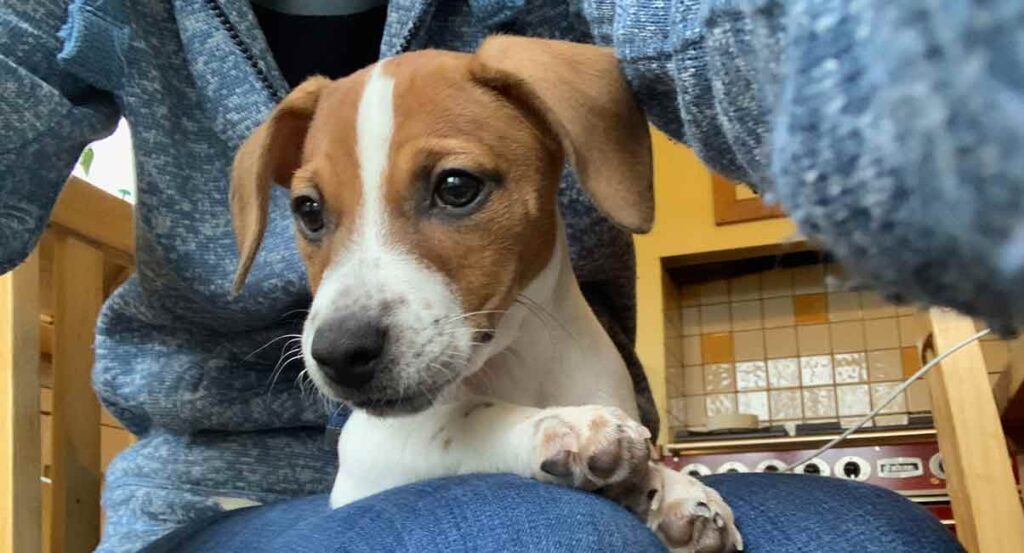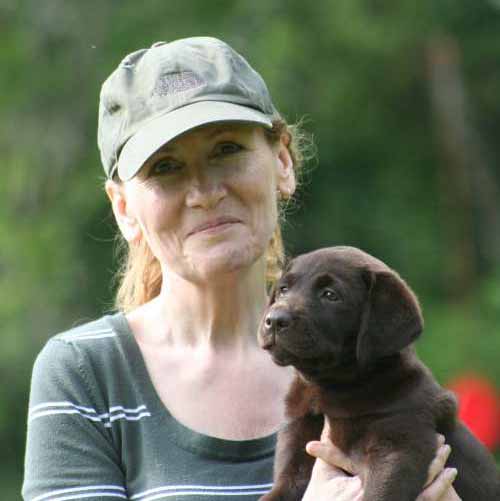Eating trash has to be a favorite activity for many dogs. But what about when that enthusiasm extends to all kinds of gross snacks, such as slugs, a dead rabbit, frogs and the occasional dead bird?

One of my springer spaniels would go out of her way to hunt down every slug in the garden, and several of my current dogs enjoy catching flies. Both of these habits carry a risk, and I’ll talk about that below.
The things dogs eat! We’ll talk about these:
Dogs eat these kinds of things because, well because they are dogs! It’s nothing to do with not being fed often enough, and it doesn’t mean your dogs aren’t getting enough nutrients.
Eating carrion, and invertebrates like beetles and worms, is actually quite natural for a small to medium sized carnivore.
Will my dog be okay?
So if it’s natural, does it mean it’s harmless? Are slugs poisonous? And will your dog be okay if they just swallowed a large fat snail?
And what about that seagull carcass that your dog found on the beach? Surely that was crawling with germs?
So there are four areas of risk here.
- Risk of being stung
- Risk of being poisoned
- Risk from bacteria
- Risk from parasites
And the risk to your dog will depend on what they ate
Eating insects and the risk of a sting
If your dog enjoys catching and eating flies and beetles, the main risk is that they will make the mistake of picking up a yellowjacket, or some other stinging or biting insect.
Eating flies, dead or alive, is not usually harmful in itself. The worry is that your dog will be stung somewhere that might affect their airway.
If you see your dog poking a wasp or fly, it’s a good idea to distract them if you can. My dogs are fed raw meat and this can attract wasps during the summer. So I make sure to feed them in the coolest part of the day to minimize this risk. Other than that there’s not a lot more you can do about this particular risk.
If you are concerned that your dog has been stung in their mouth, it’s a good idea to contact your veterinarian. But a sting that results in disaster does seem to be a very rare event.
Slugs, snails and lungworm
Eating a slug or snail carries a little more risk for your dog, not because they are poisonous, dirty or harmful in themselves, but because slugs are a host for lungworm.
If your dog swallows a slug containing lungworm larvae, these can travel around your dog’s body until they reach their preferred residence, which is your dog’s heart, or the main artery connecting their heart with their lungs. Once there, they may reproduce and make more lungworms.
An infected dog may have a range of symptoms that include coughing. And if left untreated an infection can be fatal. Infected dogs will also have infected poop
The slugs pick up the worms by climbing over poop left by an infected dog, and round and round it goes.
The way to break this cycle is by regularly treating your dog for lungworm, preferably before they get infected.
This is especially important if you have a dog like my spaniel that deliberately eats slugs, or if your dog’s toys or bowls are left outside where slugs can climb on them, as the slime they leave behind can be infected too!
If your dog is being regularly treated for lungworm, then you don’t need to worry about infection if they swallow a slug or snail.
Frogs and toads
Frogs can also pass on lungworm, so if your dog has eaten a dead frog then a quick chat with your veterinarian about whether or not to treat your dog for lungworm, is a good plan.
Most dogs will not swallow toads because they taste appalling (I haven’t tried one, but I have it on good authority!) The reason for the taste is because toads secrete a toxin through their skin.
In most cases this irritates the dog’s mouth causing discomfort and drooling, but it can also cause vomiting and diahorrea. The dog then leaves toads alone in the future.
In some areas its a more serious matter. There are species of toad, the cane toad is an example, that secrete a potentially lethal toxin. If in doubt, check with your veterinarian without delay because the toxin can act rapidly.
Eating dead rabbits and birds
Dead and rotting animals are very attractive to dogs. Some dogs, like my Labrador, just like to roll in them which is pretty unpleasant. Other dogs like to go one step further and actually consume the dead animal.
The first thing to say is that there’s no need to panic if your dog eats a dead rabbit, or a seagull, or anything else of that nature.
Yes they have bones, and yes they are crawling in microscopic life. Some of which would make you or I, quite ill. Fortunately a dog’s stomach is well equipped to deal with both bones, and germs.
Most dogs suffer no ill effects at all from eating dead animals. If your dog develops an upset stomach after their gruesome snack, keep an eye on them and if they are not better in 24 hours, or if they are elderly, or their immunity is compromised, get them checked over by your veterinarian.
All dogs do it
Try not to worry too much if your dog eats something they shouldn’t. All dogs do it, and most come to no harm.
Some dogs eat some very bizarre things indeed. What’s the weirdest thing your dog ever ate? Share with our readers in the comments below!

Free Training Tips
Get Pippa's free dog training tips delivered to your inbox

 Paws Off My Pizza! (Or How To Stop A Dog From Begging At The Table)
Paws Off My Pizza! (Or How To Stop A Dog From Begging At The Table)
Our Cavelier King Charles Spaniel loves to eat jigsaw puzzle pieces! If any drop on the floor he will be the first to find them. ( My son is always working on jigsaws).
His recall is good, (we trained using your book’Total Recall’) unless he finds a dead animal or he sees a squirrel! Really hard to train this! Any suggestions? Thanks! Your articles are extremely helpful.
Hi Nicki, teaching your dog to recall when there are strong distractions is really important but you need to work up to it in stages. Lots of practice at focus and attention games, as well as recall, will help. And you might want to consider having your dog wear a training leash in areas where you think they might be tempted to chase wildlife. There is more info in this article Glad you are finding the articles helpful. Do join the support group if you need more help 🙂
A friend’s beagle would pull tissues out of the box and eat them, amongst many other things.
The highlight was a small brass bell, which passed unharmed and undigested through his digestive tract and reappeared at the other end after an anxious 2 or 3 days!
That sounds like quite a worry for the Beagle’s owner! So glad the dog was unharmed!
Hello, my pet dog namely Wookey has swallowed a little slug today. I have read of “lungworm” & I am slightly concerned. What is your advice? I plan to contact my vet for him to have some treatment to prevent lungworm.
Hi Hayley. A chat with your vet sounds a good plan – they can advise you about lungworm treatment, both for now, and potentially as a regular treatment going forward for your pup :). Sammie.